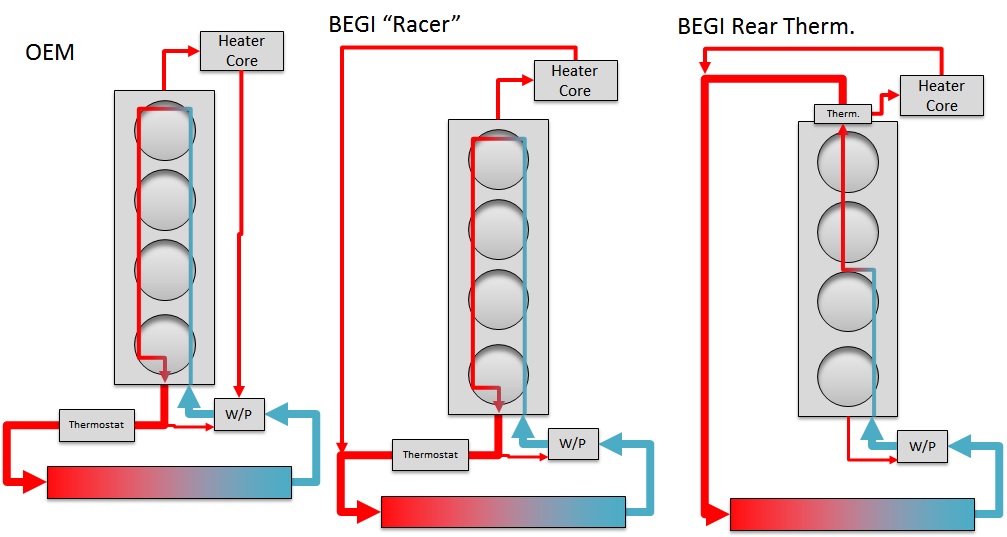Why You NEED a Reroute (and why it should NOT be a BEGI racer reroute)
#1
Thread Starter
Elite Member
iTrader: (4)
Joined: Mar 2008
Posts: 6,301
Total Cats: 696
From: Granbury, TX
This is an outgrowth of Concealer404's thread on overcooling with a BEGI "Racer" reroute. As part of that thread, I got on Visio and drew up some cooling diagrams. They present the whole reroute issue so clearly that I thought they were worth posting for general interest. As they say, a picture is worth a thousand words.
First, let's start with the OEM coolant routing:
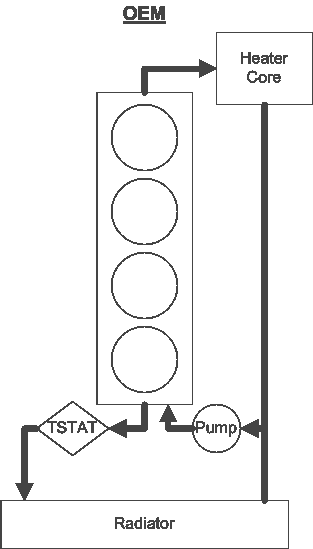
Mazda's dilemna was fitting a FWD transverse engine to a RWD chassis. To preserve maintainability, they wanted the thermostat in the front. They had room to fit a large radiator, so why not?
Note that with the OEM configuration, the most even flow of water through the engine is with the thermostat closed. As the thermostat opens, the path of least resistance to get out of the engine/head moves towards the front cylinders which tends to starve the rear cylinders of cooling. Not ideal.
In addition, it means that the radiator never sees full flow no matter how open the thermostat is because some coolant always takes the path through the heater core. That means radiator efficiency is also compromised -- which is one reason our radiator is more than twice as large as a Civic's.
So, the Mazda engineers paid a heavy price for that front thermostat. But they weren't dumb. They sized the components so that the engine retained adequate cooling water (at OEM power levels) with the thermostat fully open in hot conditions.
Alas, who among us is happy at OEM power levels? #4 gets awfully hot when you bump it up. Hence . . . the traditional reroute:
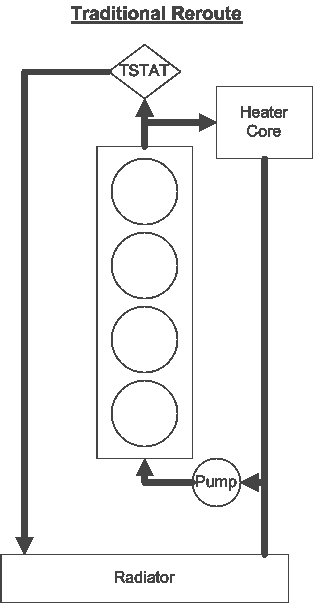
Since we're men and don't fear blood on our knuckles, the traditional and best way to reroute is to restore the flow of coolant to the FWD transverse configuration. This is really the optimum configuration. Every bit of water goes through the entire engine from front to back cooling every cylinder. Doesn't get much simpler or effective than this. On my cars, I do this with a BEGI spacer, KIA waterneck, GM truck hose and TSE waterneck block-off. BAM!! (Relatively cheap too).
The above seems so obvious. So, what might be this BEGI "Racer" reroute I'm reading about? Went to BEGI's website to check it out. Aaaannnddd . . . here it is in all it's glory:
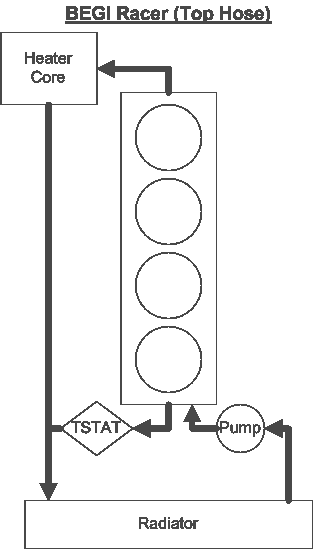
In this setup, all water always goes through the radiator with some of it going through the heater core as well. So, expect LOOOONNNNGGG warmup times (under some conditions you may never warm up). Plus, the deficiency with water balance through the engine remains. WAIT!!! Actually . . . it's worse!!! How can that be?
Look carefully. The highest pressure point in the system is the water pump outlet. Likewise the lowest pressure point in the system is the water pump inlet. The water pump belt provides the mechanical power to make this happen. Now, with the OEM system the flow through the rearmost cylinders is:
1. pump outlet
2. rear cylinders
3. heater core
4. pump inlet
But, with this system, the flow is:
1. pump outlet
2. rear cylinders
3. heater core
4. radiator
5. pump inlet
The benefits of this system is that it increases water flow through the radiator and doesn't mix water from the heater core (which may not have been cooled) into the water pump inlet. Only the radiator feeds the water pump inlet. But it doesn't fix the cooling balance problem and may make it worse. And, of course, it may never warm up. Not good.
Some recommend "fixing" this reroute by moving the T into the lower hose. Here's what that looks like:
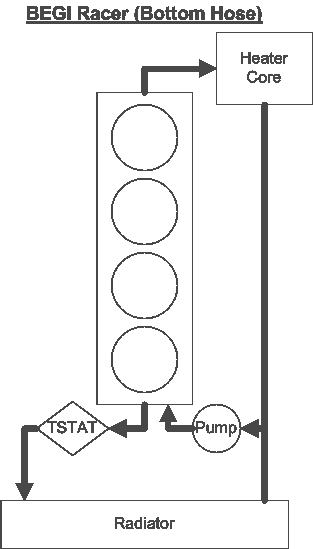
Bears an uncanny resemblance to the OEM system, doesn't it? LOL. At least it's better than a T in the top hose.
TL;DR . . . if bumping power, install a traditional reroute. Avoid the BEGI racer reroute.
First, let's start with the OEM coolant routing:

Mazda's dilemna was fitting a FWD transverse engine to a RWD chassis. To preserve maintainability, they wanted the thermostat in the front. They had room to fit a large radiator, so why not?
Note that with the OEM configuration, the most even flow of water through the engine is with the thermostat closed. As the thermostat opens, the path of least resistance to get out of the engine/head moves towards the front cylinders which tends to starve the rear cylinders of cooling. Not ideal.
In addition, it means that the radiator never sees full flow no matter how open the thermostat is because some coolant always takes the path through the heater core. That means radiator efficiency is also compromised -- which is one reason our radiator is more than twice as large as a Civic's.
So, the Mazda engineers paid a heavy price for that front thermostat. But they weren't dumb. They sized the components so that the engine retained adequate cooling water (at OEM power levels) with the thermostat fully open in hot conditions.
Alas, who among us is happy at OEM power levels? #4 gets awfully hot when you bump it up. Hence . . . the traditional reroute:

Since we're men and don't fear blood on our knuckles, the traditional and best way to reroute is to restore the flow of coolant to the FWD transverse configuration. This is really the optimum configuration. Every bit of water goes through the entire engine from front to back cooling every cylinder. Doesn't get much simpler or effective than this. On my cars, I do this with a BEGI spacer, KIA waterneck, GM truck hose and TSE waterneck block-off. BAM!! (Relatively cheap too).
The above seems so obvious. So, what might be this BEGI "Racer" reroute I'm reading about? Went to BEGI's website to check it out. Aaaannnddd . . . here it is in all it's glory:

In this setup, all water always goes through the radiator with some of it going through the heater core as well. So, expect LOOOONNNNGGG warmup times (under some conditions you may never warm up). Plus, the deficiency with water balance through the engine remains. WAIT!!! Actually . . . it's worse!!! How can that be?
Look carefully. The highest pressure point in the system is the water pump outlet. Likewise the lowest pressure point in the system is the water pump inlet. The water pump belt provides the mechanical power to make this happen. Now, with the OEM system the flow through the rearmost cylinders is:
1. pump outlet
2. rear cylinders
3. heater core
4. pump inlet
But, with this system, the flow is:
1. pump outlet
2. rear cylinders
3. heater core
4. radiator
5. pump inlet
The benefits of this system is that it increases water flow through the radiator and doesn't mix water from the heater core (which may not have been cooled) into the water pump inlet. Only the radiator feeds the water pump inlet. But it doesn't fix the cooling balance problem and may make it worse. And, of course, it may never warm up. Not good.
Some recommend "fixing" this reroute by moving the T into the lower hose. Here's what that looks like:

Bears an uncanny resemblance to the OEM system, doesn't it? LOL. At least it's better than a T in the top hose.
TL;DR . . . if bumping power, install a traditional reroute. Avoid the BEGI racer reroute.
Last edited by hornetball; 02-27-2014 at 03:01 PM. Reason: Correct diagrams/writeup based upon Brainy input
#5
It's a little more complicated than this, but yeah, pretty much right.
It does fail to distinguish between thermostat open routing and thermostat closed routing, and where it routes through the block.
For instance, in the OEM routing, it doesn't accurately show how the water doesn't go through the block when warm, instead mostly going right back out the front neck.
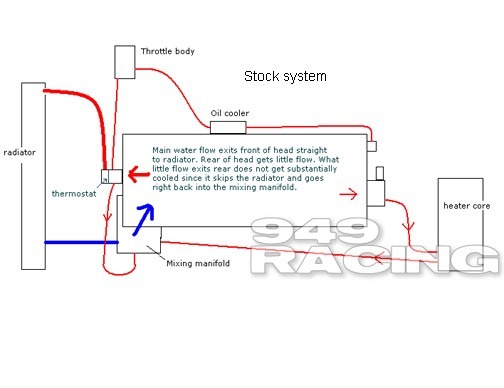
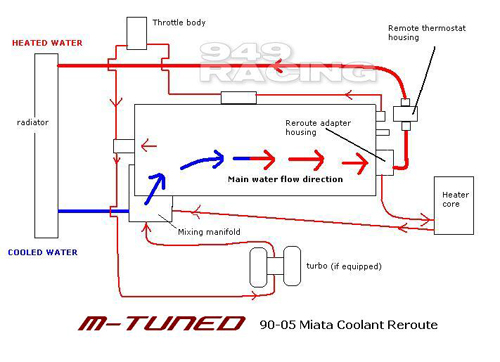
Basically I like the colored pictures.
It does fail to distinguish between thermostat open routing and thermostat closed routing, and where it routes through the block.
For instance, in the OEM routing, it doesn't accurately show how the water doesn't go through the block when warm, instead mostly going right back out the front neck.


Basically I like the colored pictures.
#9
Thread Starter
Elite Member
iTrader: (4)
Joined: Mar 2008
Posts: 6,301
Total Cats: 696
From: Granbury, TX
From 2001 onward, the OEM head gasket restricted flow to the front of the cylinder head to force more water to the rear. This amounts to "water balancing." Definitely beneficial at OEM power levels. May not be enough at elevated power levels.
949 recommends changing to an earlier headgasket if a traditional reroute is installed.
949 recommends changing to an earlier headgasket if a traditional reroute is installed.
Last edited by hornetball; 02-27-2014 at 02:55 PM. Reason: Correct response based upon main writeup corrections
#13
Thread Starter
Elite Member
iTrader: (4)
Joined: Mar 2008
Posts: 6,301
Total Cats: 696
From: Granbury, TX
Yeah, those diagrams are better. Shows how water goes into the block and out from the head. Main writeup has been corrected to show this important detail. Thanks.
Last edited by hornetball; 02-27-2014 at 07:54 PM.
#15
Hey guys, what if you did a reroute with the thermostat on the back of the head, but also left the thermostat/housing in the stock location!? Then plumb them together into the radiator.
It would be like double the cooling.
A true revolutionary innovation! Dare I call it The Holy Grail of reroutes!?
It would be like double the cooling.
A true revolutionary innovation! Dare I call it The Holy Grail of reroutes!?
#16
I'm still confused on the consensus on 01+ and a reroute...haha. I was running the reroute awhile back, but took it off when HG design was discovered and it was understood that it was a "bad" idea. That was also when livin in the hot n' humid Southeast. Now that I'm in the much cooler and dryer PNW, I feel the stock setup with the standard large radiator should be good.
#17
Hey guys, what if you did a reroute with the thermostat on the back of the head, but also left the thermostat/housing in the stock location!? Then plumb them together into the radiator.
It would be like double the cooling.
A true revolutionary innovation! Dare I call it The Holy Grail of reroutes!?
It would be like double the cooling.
A true revolutionary innovation! Dare I call it The Holy Grail of reroutes!?
BEGi actually suggested that for a while. I think using two temperature stats.
#18
I'm still confused on the consensus on 01+ and a reroute...haha. I was running the reroute awhile back, but took it off when HG design was discovered and it was understood that it was a "bad" idea. That was also when livin in the hot n' humid Southeast. Now that I'm in the much cooler and dryer PNW, I feel the stock setup with the standard large radiator should be good.








